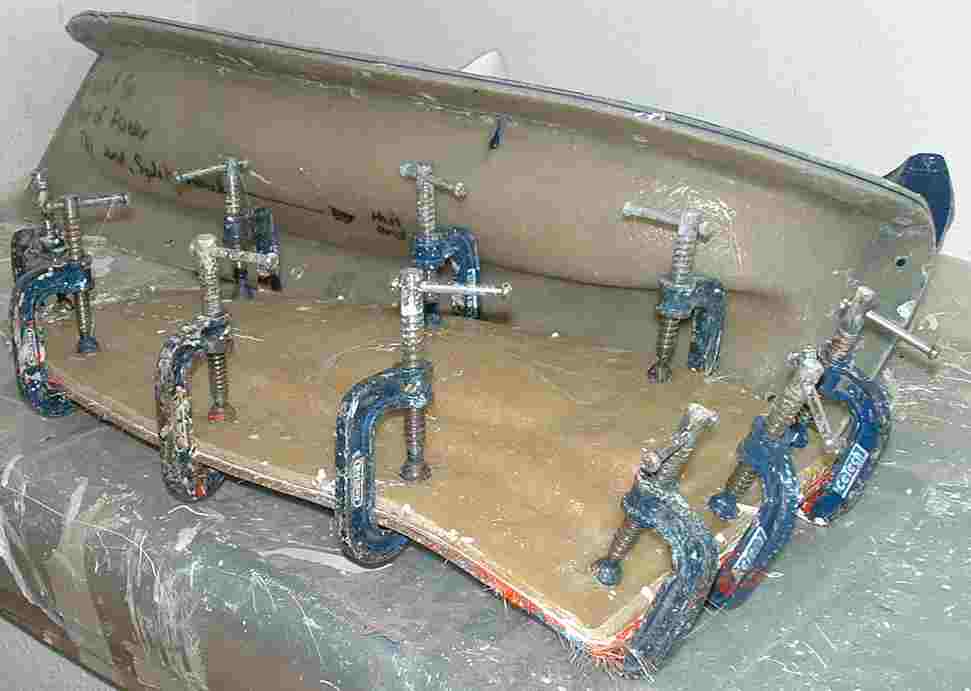|
ADHESIVES
|
||||||||||
|
Like many small boys, my love affair with adhesives began with sticky tape (Sellotape) and progressed through contact adhesives such as Evo-Stick, solvent model cements, to Araldite. Later, when I was much older came Super-Glues. I was almost obsessed with the power these glues gave me, when making things. In fact, I remember having a collection of the entire Bostik range. I was easily pleased at the age of 10.
An adhesive is basically any compound that adheres or bonds two items together. Adhesives may come from either natural or synthetic sources. Some modern adhesives are extremely strong, and are becoming increasingly important in modern construction and industry.
"A sticky subject"
HISTORY
The first adhesives were gums and other plant resins. Archaeologists have found 6000-year-old ceramic vessels that had broken and been repaired using plant resin. Most early adhesives were animal glues made by rendering animal products such as the Native American use of buffalo hooves. Native Americans in what is now the eastern United States used a mixture of spruce gum and fat as adhesives and as caulk to waterproof seams in their birchbark canoes. During the times of Babylonia, tar-like glue was used for gluing statues. Also, Egypt was one of the most prominent users of adhesives. The Egyptians used animal glues to adhere tombs, furniture, ivory, and papyrus. Also, the Mongols used adhesives to make their short bows. In Europe in the Middle Ages, egg whites were used to decorate parchments with gold leaves. In the 1700s, the first glue factory was founded in Holland, which manufactured hide glue. Later, in the 1750s, the British introduced fish glue. As the modernization continued, new patents were issued by using rubber, bones, starch, fish, and casein. Modern adhesives have improved flexibility, toughness, curing rate, temperature and chemical resistance. (HSL)
Natural adhesives
Adhesives based on vegetable (natural resin), food (animal hide and skin), and mineral sources (inorganic materials).
Synthetic adhesives
Adhesives based on elastomers, thermoplastic, and thermosetting adhesives.
Drying adhesives
These adhesives are a mixture of ingredients (typically polymers) dissolved in a solvent. Glues and rubber cements are members of the drying adhesive family. As the solvent evaporates, the adhesive hardens. Depending on the chemical composition of the adhesive, they will adhere to different materials to greater or lesser degrees. These adhesives are typically weak and are used for household applications. Some intended for small children are now made non-toxic.
Hot glue gun, an example of a semi industrial adhesive and very useful in model making
Hot adhesives (thermoplastic adhesives)
Also known as "hot melt" adhesives, these adhesives are thermoplastics; they are applied hot and simply allowed to harden as they cool. These adhesives have become popular for crafts because of their ease of use and the wide range of common materials to which they can adhere. A glue gun, pictured right, is one method of applying a hot adhesive. The glue gun melts the solid adhesive and then allows the liquid to pass through the "barrel" of the gun onto the material where it solidifies.
Reactive adhesives
A reactive adhesive is a result of chemical bonding with the surface material, reactive adhesives are applied in thin films. Reactive adhesives are less effective when there is a secondary goal of filling gaps between the surfaces..
Such adhesives are frequently used to prevent loosening of bolts and screws in rapidly moving assemblies, such as automobile engines. They are largely responsible for the quieter running modern car engines.
Pressure sensitive adhesives
In order to form a permanent bond, structural adhesives harden via processes such as evaporation of solvent or water (white glue), reaction with radiation (dental adhesives), chemical reaction (two part epoxy), or cooling (hot melt), as described above. In contrast, pressure sensitive adhesives (PSAs) form a bond simply by the application of light pressure to marry the adhesive with the adherend. Pressure sensitive adhesives are designed with a balance between flow and resistance to flow. The bond forms because the adhesive is soft enough to flow, or wet, the adherend. The bond has strength because the adhesive is hard enough to resist flow when stress is applied to the bond. Once the adhesive and the adherend are in close proximity, there are also molecular interactions such as val der Waals forces involved in the bond. These contribute significantly to the ultimate bond strength.
Pressure sensitive adhesives (PSAs) are designed for either permanent or removable applications. Examples of permanent applications include safety labels for power equipment, foil tape for HVAC duct work, automotive interior trim assembly, and sound/vibration damping films. Some high performance permanent PSAs exhibit high adhesion values and can support kilograms of weight per square centimeter of contact area, even at elevated temperature. Permanent PSAs may be initially removable (for example to recover mislabeled goods) and build adhesion to a permanent bond after several hours or days.
Removable adhesives are designed to form a temporary bond, and ideally can be removed after months or years without leaving residue on the adherend. Removable adhesives are used in applications such as surface protection films, masking tapes, bookmark and note papers, price marking labels, promotional graphics materials, and for skin contact (wound care dressings, EKG electrodes, athletic tape, analgesic and transdermal drug patches, etc.). Some removable adhesives are designed to repeatedly stick and unstick. They have low adhesion and generally can not support much weight.
Pressure sensitive adhesives are manufactured with either a liquid carrier or in 100% solid form. Articles are made from liquid PSAs by coating the adhesive and drying off the solvent or water carrier. They may be further heated to initate a crosslinking reaction and increase molecular weight. 100% solid PSAs may be low viscosity polymers that are coated and then reacted with radiation to increase molecular weight and form the adheisve; or they may be high viscosity materials that are heated to reduce viscosity enough to allow coating, and then cooled to their final form.
Plastic wrap displays temporary adhesive properties as well.
Mechanisms of adhesion
The strength of attachment, or adhesion, between an adhesive and its substrate depends on many factors, including the means by which this occurs. Adhesion may occur either by mechanical means, in which the adhesive works its way into small pores of the substrate, or by one of several chemical mechanisms.
In some cases an actual chemical bond occurs between adhesive and substrate. In others electrostatic forces, as in static electricity, hold the substances together. A third chemical method involves van der Waal's forces which develop between each's molecules. Such forces also seem to account for the "stickiness" of a gecko's feet. A fourth chemical means involves the moisture-aided diffusion of the glue into the substrate, followed by hardening.
Adhesive failure
Adhesives may fail in one of two ways:
Adhesive failure is the failure of the adhesive to stick or bond with the material to be adhered (also known as the substrate or adherend).
Cohesive failure is structural failure of the adhesive. Adhesive remains on both substrate surfaces, but the two items separate.
Two substrates can also separate through structural failure of one of the substrates; this is not a failure of the adhesive. In this case the adhesive remains intact and is still bonded to one substrate and the remnants of the other. For example, when one removes a price label, adhesive usually remains on the label and the surface. This is cohesive failure. If, however, a layer of paper remains stuck to the surface, the adhesive has not failed. As another example, when someone tries to pull apart Oreo cookies with the filling all on one side. The goal is an adhesive failure, rather than a cohesive failure.
COMPOSITE DIRECTORY
LINKS:
|
||||||||||
|
This
website is Copyright
© 1999 & 2013 Max Energy Ltd. The name Solar Navigator are
the bluebird
logo
|
||||||||||


